Water infrastructure faces unprecedented challenges – aging assets, climate pressures, and rising operational costs strain utilities worldwide. Enter Altillion, an innovative force reshaping how we manage water systems through advanced digital intelligence. By fusing AI-powered analytics with deep water sector expertise, Altillion empowers utilities to extract actionable insights from their data, optimize operations, and build resilience for tomorrow’s demands. This revolution in smart water management isn’t just about technology – it’s about ensuring sustainable water services for generations to come.
with 🎙️ Jay Keener, CEO & Co-Founder at Altillion
Take-home message (in 2 long sentences 😅):
Altillion revolutionizes lithium extraction through a proprietary liquid-liquid process that recovers organic chemicals with near-perfect efficiency, eliminating the solvent losses plaguing traditional extraction methods. Their sophisticated system functions as the ultimate post-DLE polishing technology, transforming moderately concentrated lithium streams into battery-grade materials without requiring the costly thermal evaporation and multiple process steps that competitors rely on.
In this episode, you’ll learn:
🧪 How Altillion’s liquid-liquid extraction process differs from traditional solvent extraction and why it virtually eliminates chemistry losses
💡 Why the company pivoted from being a standalone DLE solution to focusing on post-DLE concentration and purification where its technology truly excels
🔄 How partnerships with other DLE providers create synergies rather than competition in the lithium extraction ecosystem
💰 What drives the economics behind lithium recovery projects and why reducing CAPEX through flow sheet simplification is becoming increasingly critical
🌐 Where Altillion’s technology fits in the broader mineral recovery landscape beyond lithium and how it scales from pilot to commercial implementation
Let’s get into it!
undefined
undefined
The Water Industry’s Digital Wake-Up Call
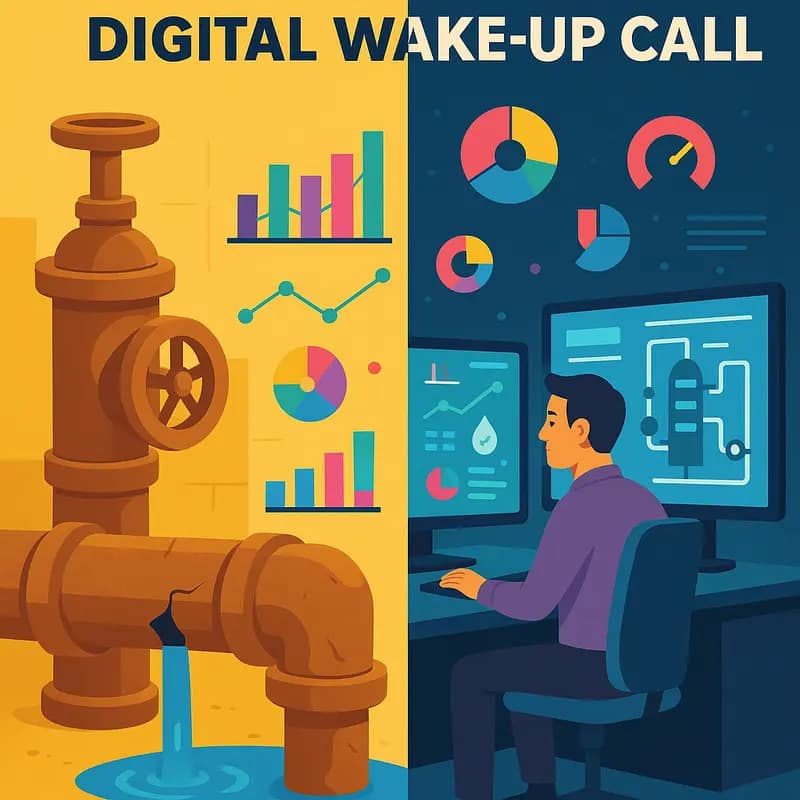
Aging infrastructure, rising operational costs, and increasing service demands are creating unprecedented pressure on water utilities worldwide. Legacy systems, some dating back over a century, are failing at alarming rates while utilities struggle to fund essential maintenance and upgrades. Infrastructure replacement costs alone are projected to exceed $1 trillion in the coming decades.
This mounting crisis has exposed critical weaknesses in traditional infrastructure management approaches. Paper-based workflows, reactive maintenance, and siloed data systems severely limit utilities’ ability to make informed decisions about their assets. Without comprehensive visibility into system performance, utilities often resort to inefficient blanket replacement programs or crisis-driven repairs.
The financial implications are staggering. Non-revenue water from leaks and asset failures costs utilities billions annually in lost revenue. Meanwhile, emergency repairs typically cost 5-10 times more than planned maintenance. These challenges are further amplified by workforce transitions, as utilities lose decades of institutional knowledge through retiring senior staff.
However, this crisis has become a powerful catalyst for digital transformation. Forward-thinking utilities are embracing digital solutions that leverage artificial intelligence, IoT sensors, and advanced analytics to revolutionize asset management. These technologies enable predictive maintenance, optimize operations, and provide unprecedented insight into infrastructure health.
The benefits extend beyond cost savings. Digital transformation allows utilities to extend asset lifespans, improve service reliability, and make data-driven investment decisions. Real-time monitoring and automated analysis help identify potential failures before they occur, while machine learning algorithms optimize maintenance schedules and resource allocation.
As regulatory pressures increase and infrastructure continues to age, the water industry’s digital awakening isn’t just an opportunity—it’s an imperative. Utilities that fail to embrace this transformation risk falling further behind, trapped in an unsustainable cycle of reactive management and escalating costs. The future of water infrastructure management will belong to those who successfully harness digital intelligence to drive operational excellence.
Altillion’s AI-Powered Asset Intelligence
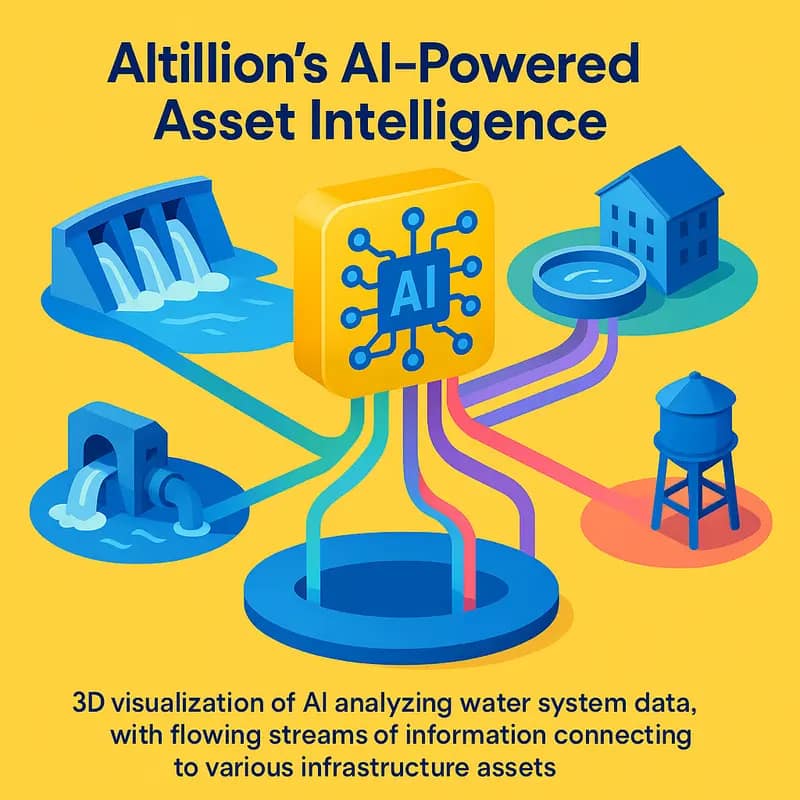
At the core of Altillion’s breakthrough water asset management platform lies a sophisticated artificial intelligence engine that transforms raw utility data into actionable intelligence. The system processes millions of data points from sensors, maintenance records, and operational metrics to build comprehensive digital twins of water infrastructure networks.
The platform’s neural networks continuously analyze performance patterns across pumps, pipes, treatment facilities, and distribution systems. By detecting subtle anomalies and correlations invisible to human operators, the AI can predict potential failures weeks or months before they occur. This predictive capability helps utilities shift from reactive maintenance to proactive asset optimization.
What sets Altillion’s technology apart is its ability to learn and adapt based on each utility’s unique operating environment. The AI doesn’t just apply generic rules – it develops facility-specific insights by understanding the complex interplay between infrastructure age, usage patterns, environmental conditions, and maintenance history. This contextual awareness enables highly accurate predictions tailored to individual utilities’ needs.
The platform’s machine learning algorithms also excel at optimizing system-wide performance. By analyzing historical operational data alongside real-time inputs, the AI can recommend optimal pump schedules, chemical dosing rates, and maintenance interventions that reduce energy consumption while extending asset lifespans. Learn more about leveraging smart data analytics to prevent infrastructure issues.
Beyond operational insights, Altillion’s AI provides strategic intelligence for capital planning. The system’s predictive models help utilities understand infrastructure deterioration rates and identify which assets should be prioritized for replacement or rehabilitation. This data-driven approach ensures limited capital budgets deliver maximum impact.
By combining advanced AI capabilities with deep domain expertise in water infrastructure, Altillion has created a platform that doesn’t just collect data – it transforms that data into clear, actionable recommendations that drive better decisions across all levels of utility operations.
From Data to Decisions: The Altillion Advantage
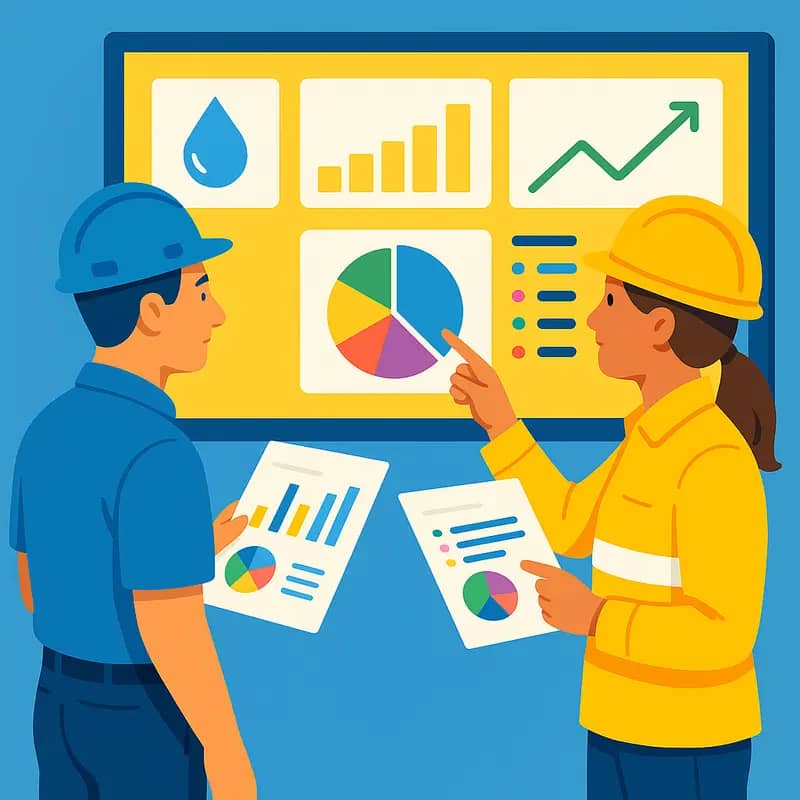
Water utilities worldwide are transforming their operations through data-driven decision making. A Pacific Northwest utility facing aging infrastructure challenges leveraged advanced analytics to optimize its maintenance strategy. By analyzing sensor data from critical pumping stations, the utility identified early warning signs of equipment deterioration and prioritized preventive repairs, reducing emergency maintenance costs by 35% while extending asset lifespans.
In drought-prone regions, utilities are using predictive modeling to make smarter investment decisions. A metropolitan water district in the Southwest integrated climate data, consumption patterns, and infrastructure performance metrics to develop a 20-year capital improvement plan. This data-centric approach helped them target high-impact projects that maximized water conservation while optimizing their limited budget.
The transformative power of digital intelligence extends beyond asset management. A mid-sized utility struggling with water quality compliance implemented real-time monitoring and AI-powered analysis across its distribution network. The system now automatically detects anomalies and predicts potential water quality issues before they impact customers, leading to a 40% reduction in water quality incidents.
Perhaps most impressive are the outcomes in leak detection and water loss prevention. By combining pressure sensor data, flow metrics, and machine learning algorithms, utilities can now pinpoint potential leaks with unprecedented accuracy. One utility reduced its annual water losses by 2.8 billion gallons after implementing smart leak detection, demonstrating how digital intelligence can dramatically improve operational efficiency.
These real-world applications showcase how utilities are moving beyond simple data collection to achieve tangible operational improvements. The key lies in transforming raw data into actionable intelligence that drives better decision-making across all aspects of utility operations – from infrastructure planning to customer service.
Predictive Maintenance Revolution
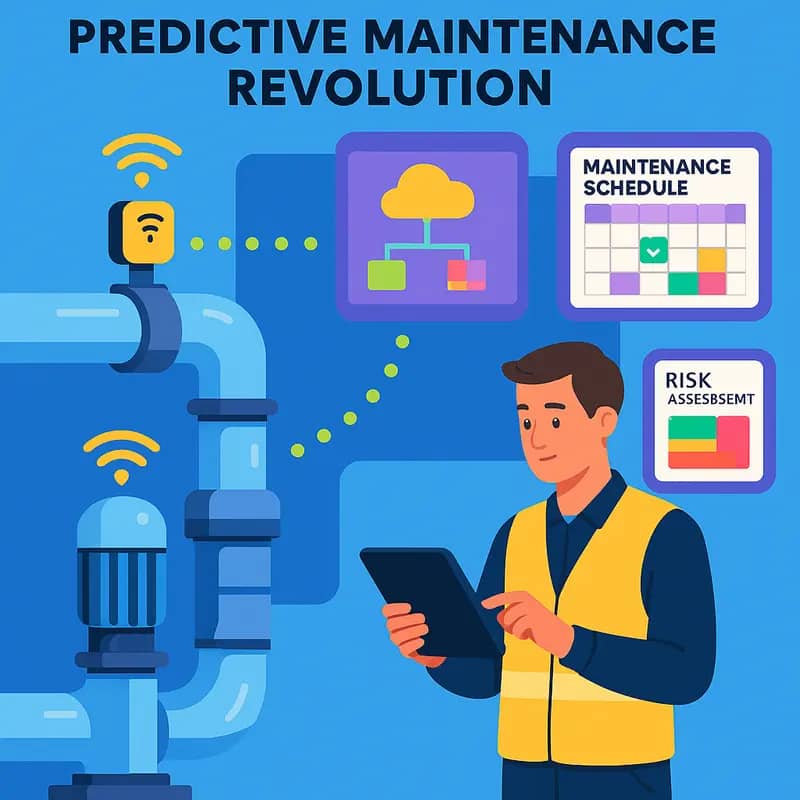
Predictive analytics has fundamentally transformed how utilities approach infrastructure maintenance, shifting from reactive repairs to proactive asset management. By analyzing vast streams of sensor data, Altillion’s advanced algorithms detect subtle patterns that indicate potential equipment failures weeks or months before they occur.
The system continuously monitors critical parameters like pressure fluctuations, flow rates, and equipment vibration patterns. When these metrics deviate from established baselines, the platform alerts operators and provides detailed diagnostic information. This early warning capability has proven particularly valuable for aging infrastructure, where unexpected failures can lead to service disruptions and costly emergency repairs.
A particularly innovative aspect is the platform’s ability to learn and adapt from historical maintenance data. By correlating maintenance records with operational data, the system progressively refines its predictive models, achieving higher accuracy rates over time. This machine learning approach helps utilities optimize their maintenance schedules and extend asset lifespans.
The economic impact has been substantial. Utilities using predictive analytics have reported maintenance cost reductions of up to 30%, while simultaneously increasing asset reliability. The platform’s ability to prioritize maintenance activities based on actual asset condition, rather than fixed schedules, ensures resources are allocated where they’re needed most.
Beyond cost savings, this predictive approach has improved operational resilience. By identifying potential failures before they occur, utilities can plan interventions during off-peak periods, minimizing service disruptions. The system also helps optimize spare parts inventory by forecasting when components will likely need replacement.
The platform’s success in predictive maintenance has broader implications for infrastructure management. As utilities face increasing pressure to maintain aging systems with limited budgets, the ability to extend asset lifespans while reducing maintenance costs has become crucial. This data-driven approach to asset management represents a significant step toward more sustainable and efficient water infrastructure operations.
Building Climate Resilience
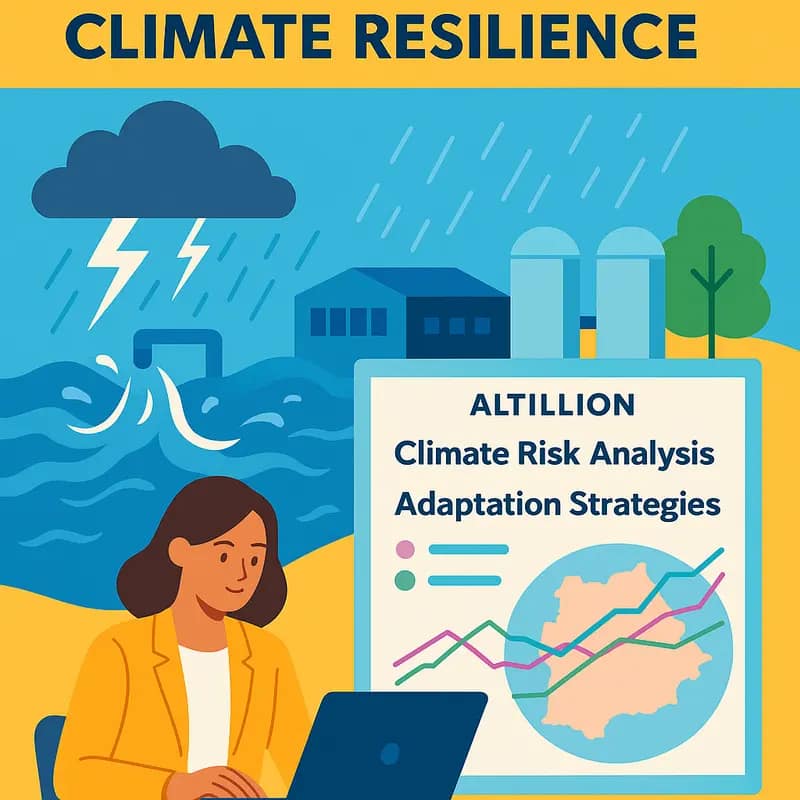
Climate change poses an unprecedented threat to water infrastructure worldwide, with intensifying weather patterns straining aging systems beyond their design parameters. Altillion’s digital intelligence platform provides utilities with powerful capabilities to strengthen their climate resilience through enhanced monitoring and proactive risk mitigation.
The platform’s advanced sensor networks and AI analytics deliver real-time insights into system performance under various weather conditions. This granular monitoring enables utilities to detect subtle changes in infrastructure behavior that may indicate emerging vulnerabilities. By analyzing historical performance data alongside climate projections, the system helps identify assets most at risk from specific climate impacts like flooding, drought, or extreme temperatures.
Risk assessment capabilities go beyond traditional methods by incorporating dynamic climate data and predictive modeling. The platform evaluates multiple risk factors simultaneously – from precipitation patterns to temperature extremes – to generate comprehensive vulnerability assessments. These insights allow utilities to prioritize upgrades and adaptations where they will have the greatest impact on system resilience.
Perhaps most importantly, Altillion’s platform enables utilities to move from reactive to proactive climate adaptation. The system’s predictive analytics can forecast potential failure points before they manifest, giving operators time to implement preventive measures. This might involve adjusting operations, reinforcing vulnerable assets, or developing contingency plans for extreme weather events.
The platform also supports long-term resilience planning by modeling various climate scenarios and their potential impacts on infrastructure. These scenario analyses help utilities make informed decisions about capital investments and system modifications to ensure their networks can withstand future climate challenges.
Through integration with existing systems and continuous learning capabilities, the platform becomes increasingly sophisticated at identifying climate-related risks and recommending targeted interventions. This evolutionary approach to climate resilience helps utilities stay ahead of emerging threats while maximizing the return on their adaptation investments.
The ROI of Digital Intelligence
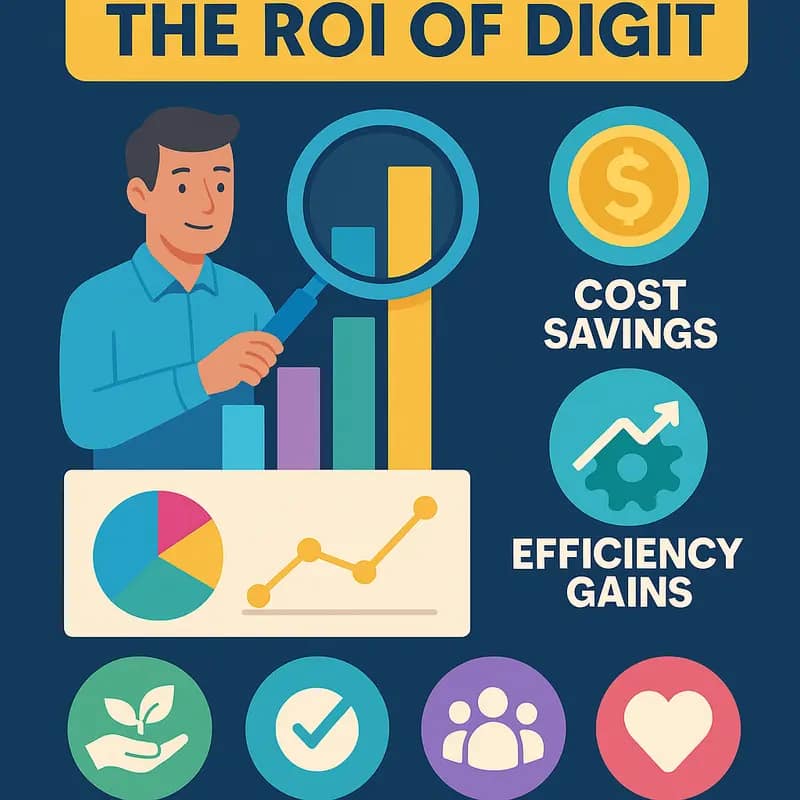
Digital intelligence transforms water utility operations from reactive maintenance to data-driven optimization, delivering measurable returns on investment across multiple dimensions. Utilities implementing AI-powered asset management solutions typically see a 15-25% reduction in operational costs within the first year.
The financial benefits materialize through several key pathways. Predictive maintenance capabilities reduce emergency repairs by up to 40%, while extending asset lifespans by 20-30%. Real-time monitoring and automated controls optimize chemical dosing and energy usage, cutting associated costs by 10-15%. Advanced leak detection identifies issues before they become catastrophic failures, preserving both infrastructure and water resources.
Beyond direct cost savings, digital intelligence elevates operational performance to new levels. System-wide visibility enables utilities to prioritize maintenance and capital investments based on actual asset conditions and risk profiles. Machine learning algorithms process vast amounts of sensor data to detect subtle patterns that human operators might miss, providing early warning of potential issues.
The workforce multiplier effect is particularly noteworthy. Digital tools augment staff capabilities, allowing utilities to do more with existing resources. Field crews work more efficiently with mobile access to asset histories and repair procedures. Control room operators make better-informed decisions supported by AI-generated insights and recommendations.
Regulatory compliance also improves as automated monitoring and reporting reduce manual data entry errors while providing comprehensive audit trails. This enhanced transparency helps utilities maintain public trust while avoiding costly violations.
Perhaps most importantly, digital intelligence creates a foundation for long-term resilience. As utilities face mounting pressures from climate change, aging infrastructure, and evolving regulations, the ability to leverage data for strategic planning becomes invaluable. The initial investment in digital transformation typically pays for itself within 18-24 months while positioning utilities to better serve their communities for decades to come.
Implementation & Integration Success

Successful implementation of digital intelligence solutions in water utilities requires a methodical, phased approach that prioritizes seamless integration with existing infrastructure while minimizing disruption to operations. The key lies in starting with a comprehensive assessment of current systems and processes before pursuing a calculated deployment strategy.
The most effective implementations begin by identifying high-impact areas where digital solutions can deliver immediate value. Real-time monitoring of critical assets, predictive maintenance scheduling, and automated reporting workflows often serve as ideal starting points. This targeted approach allows utilities to demonstrate early wins while building institutional knowledge and buy-in.
Data integration forms the cornerstone of any successful deployment. Modern water utilities often operate multiple legacy systems that weren’t designed to communicate with each other. Breaking down these data silos requires implementing standardized protocols and establishing a unified data architecture that can aggregate information from disparate sources. This enables comprehensive analytics and gives operators a complete view of their network’s performance.
Employee engagement and training are equally crucial. The most sophisticated technology will falter without properly trained staff who understand how to leverage its capabilities. A robust change management program should include hands-on training sessions, detailed documentation, and ongoing support to ensure teams can confidently operate new systems.
Secure cloud infrastructure serves as the foundation for scalable implementation. Cloud-based solutions offer flexibility in storage and computing resources while enabling remote access and real-time collaboration. However, utilities must carefully evaluate their cybersecurity protocols and establish proper safeguards to protect sensitive operational data.
Careful consideration of integration touchpoints with existing enterprise systems like SCADA, work order management, and customer information systems helps prevent operational bottlenecks. Modern APIs and middleware solutions can bridge compatibility gaps between new and legacy systems.
By following implementation best practices and maintaining focus on long-term operational goals rather than just short-term fixes, utilities can maximize their return on digital investments while building a foundation for continued innovation and improvement.
Future-Proofing Water Management
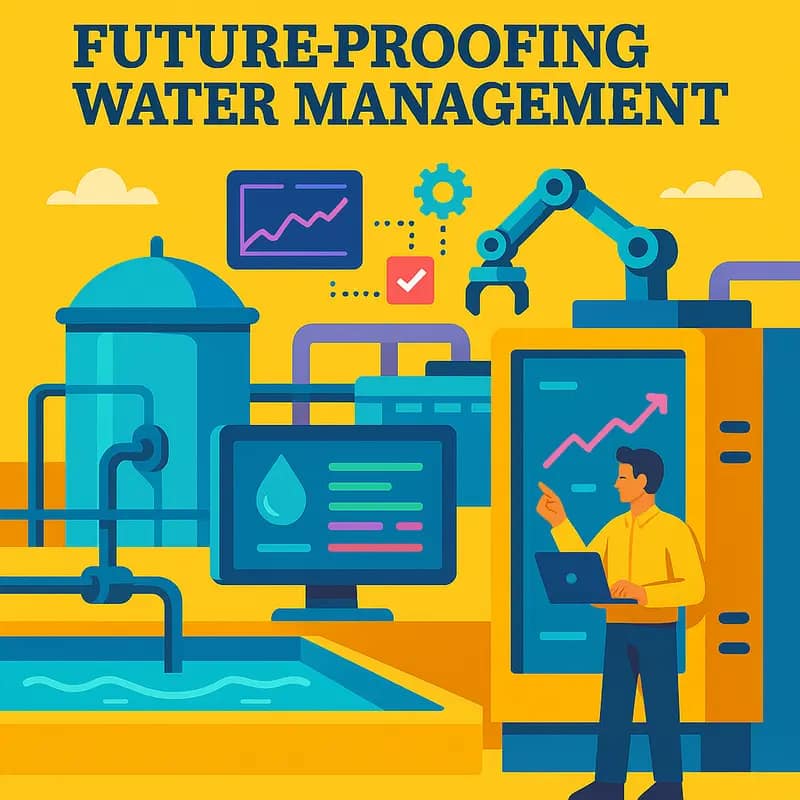
As digital intelligence transforms water infrastructure management, a revolutionary paradigm shift is emerging that will fundamentally reshape how utilities operate and maintain their assets. Advanced AI algorithms and machine learning systems will evolve beyond simple predictive maintenance to create truly autonomous water networks.
Self-healing networks will become the new standard, with AI-driven systems detecting and responding to issues before they escalate into problems. These systems will automatically adjust flow rates, pressure levels, and treatment processes in real-time, optimizing operations for maximum efficiency while maintaining water quality and availability.
Digital twins will evolve into comprehensive ecosystem models, creating virtual replicas of entire water networks that simulate not just infrastructure performance, but also environmental impacts, population growth patterns, and climate change scenarios. This holistic approach will enable utilities to stress-test their systems against future challenges and develop robust adaptation strategies.
The integration of quantum computing will revolutionize data processing capabilities, allowing for the analysis of complex datasets at unprecedented speeds. This will enable more sophisticated modeling of water systems, leading to better decision-making and resource allocation. Machine learning algorithms will continuously refine themselves, learning from each interaction and outcome to improve their predictive accuracy.
Cyber-physical systems will blur the lines between digital and physical infrastructure. Smart sensors embedded throughout the network will form an interconnected web of intelligence, sharing data and coordinating responses autonomously. These systems will leverage edge computing to process data locally, reducing latency and enabling faster response times to critical situations.
Perhaps most significantly, the democratization of water data will transform stakeholder engagement. Real-time information about water quality, usage patterns, and system performance will be accessible to utilities, regulators, and consumers alike, fostering transparency and enabling more informed decision-making at all levels.
This technological evolution will not just enhance operational efficiency – it will fundamentally change how we think about water management, moving from reactive maintenance to proactive ecosystem stewardship. The future of water infrastructure will be defined by its ability to adapt, learn, and evolve alongside the communities it serves.
The Water Infrastructure Crisis
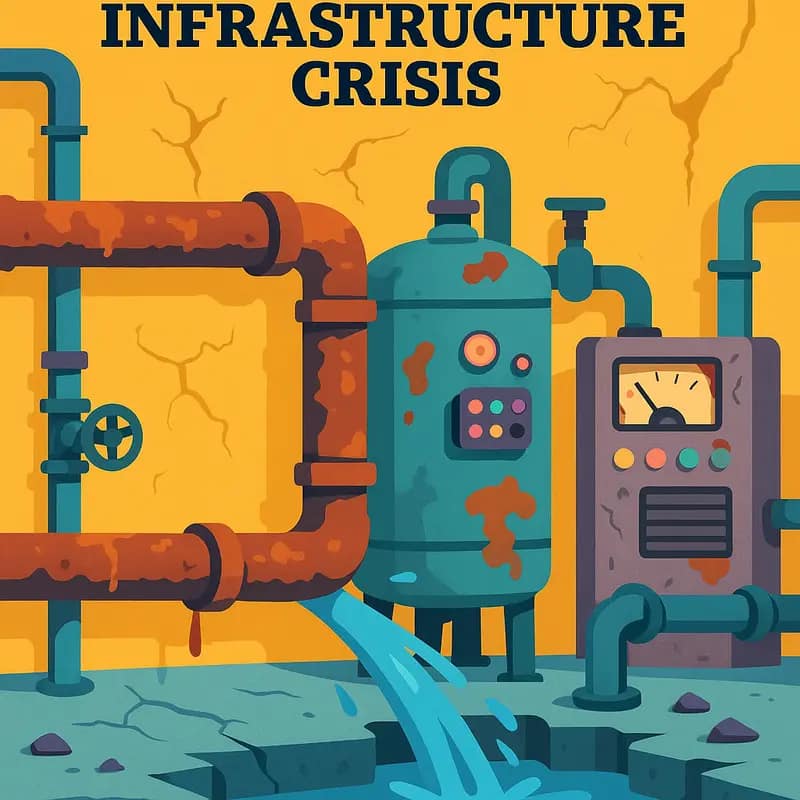
Beneath our cities lies a deteriorating maze of pipes, pumps, and treatment facilities that forms the backbone of modern civilization. This aging water infrastructure, much of it laid down in the early to mid-20th century, is now reaching a critical breaking point that threatens public health, economic stability, and environmental sustainability.
The numbers paint a stark picture: water main breaks occur every two minutes in the United States alone, wasting over two trillion gallons of treated water annually. Meanwhile, utilities face an estimated $1 trillion funding gap for essential infrastructure repairs and upgrades over the next 25 years.
This crisis is amplified by three converging challenges. First, climate change is intensifying weather extremes, subjecting infrastructure to unprecedented stresses from floods, droughts, and rising sea levels. Second, rapid urbanization is pushing aging systems beyond their designed capacities while creating new demands for water services. Third, tightening water quality regulations and emerging contaminants like PFAS require sophisticated treatment capabilities that many utilities lack.
Operational challenges compound these issues. Many utilities struggle with workforce shortages as experienced operators retire, taking decades of system knowledge with them. Manual monitoring and reactive maintenance remain standard practice, leading to inefficient resource allocation and delayed response times to critical issues.
The financial burden of these challenges falls heavily on communities. Rate increases to fund infrastructure improvements often face public resistance, while deferred maintenance only increases long-term costs. Small and rural utilities are particularly vulnerable, lacking the economies of scale to implement modern solutions.
This perfect storm of aging assets, climate impacts, and resource constraints demands a fundamental rethinking of how we manage water infrastructure. Traditional approaches focused on hardware replacement and expansion are no longer sufficient or sustainable. The sector desperately needs solutions that can maximize the performance of existing assets while providing the intelligence and adaptability to meet future challenges.
As explored in how to solve the wastewater riddle in 6 steps, innovative approaches combining smart technologies with strategic asset management offer promising paths forward. The water infrastructure crisis presents not just challenges, but opportunities to revolutionize how we protect and manage our most essential resource.
AI’s Watershed Moment
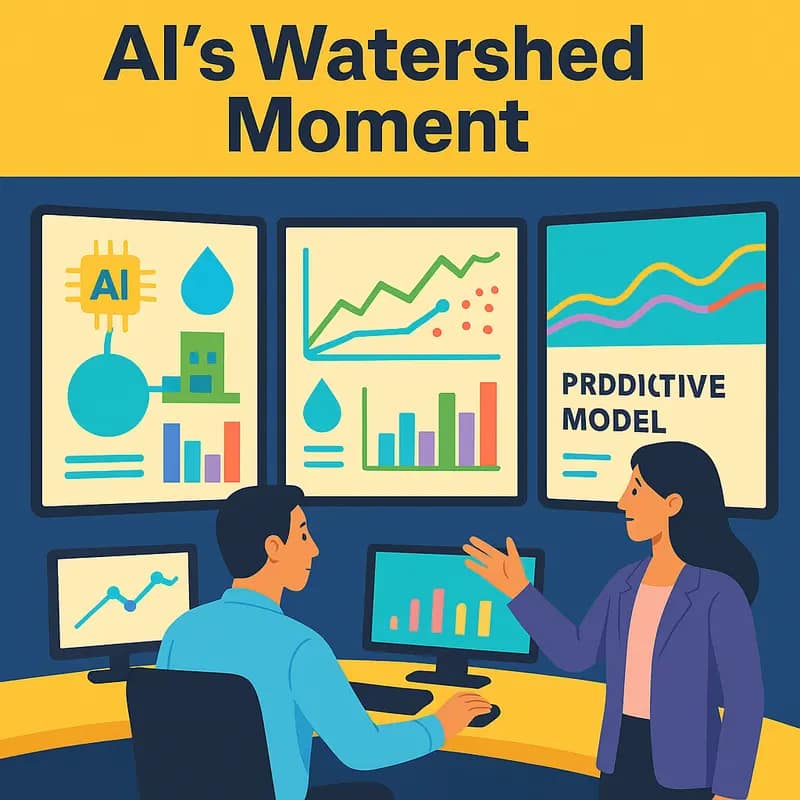
Artificial intelligence stands uniquely positioned to revolutionize water infrastructure management through its unparalleled ability to detect patterns and predict failures before they occur. The convergence of machine learning with vast streams of sensor data enables a paradigm shift in how utilities maintain and optimize their water networks.
Pattern recognition algorithms excel at identifying subtle anomalies in flow rates, pressure readings, and water quality metrics that human operators might miss. By continuously analyzing data from thousands of sensors across a network, AI can detect developing leaks, equipment degradation, and water quality issues days or weeks before traditional methods would notice them. This predictive capability empowers utilities to address problems proactively rather than reactively.
Machine learning models become increasingly accurate as they process more historical data about infrastructure performance, weather patterns, and maintenance records. The AI can correlate seemingly unrelated variables to forecast which assets are most likely to fail and when. For example, it might discover that certain pipe segments are more prone to breaks during specific weather conditions or that particular pump configurations lead to accelerated wear.
Beyond simple pattern matching, modern AI systems can optimize complex water networks in real-time. They can automatically adjust pump schedules, valve positions, and treatment processes to minimize energy usage while maintaining service quality. When integrated with smart meters and IoT sensors, AI can even help utilities implement dynamic pricing and demand management strategies.
Perhaps most importantly, AI excels at handling the uncertainty inherent in water systems. Traditional modeling approaches struggle with the variability of rainfall, changing usage patterns, and aging infrastructure. Machine learning algorithms can account for these uncertainties by continuously updating their predictions based on new data. This adaptive capability proves especially valuable as utilities face mounting challenges from climate change and population growth.
The technology’s transformative potential extends beyond operational efficiency. AI-powered analytics can help utilities make more informed infrastructure investment decisions, prioritize maintenance activities, and better engage with customers. As water systems grow more complex and interconnected, artificial intelligence becomes not just an advantage but a necessity for effective management.
The Altillion Advantage
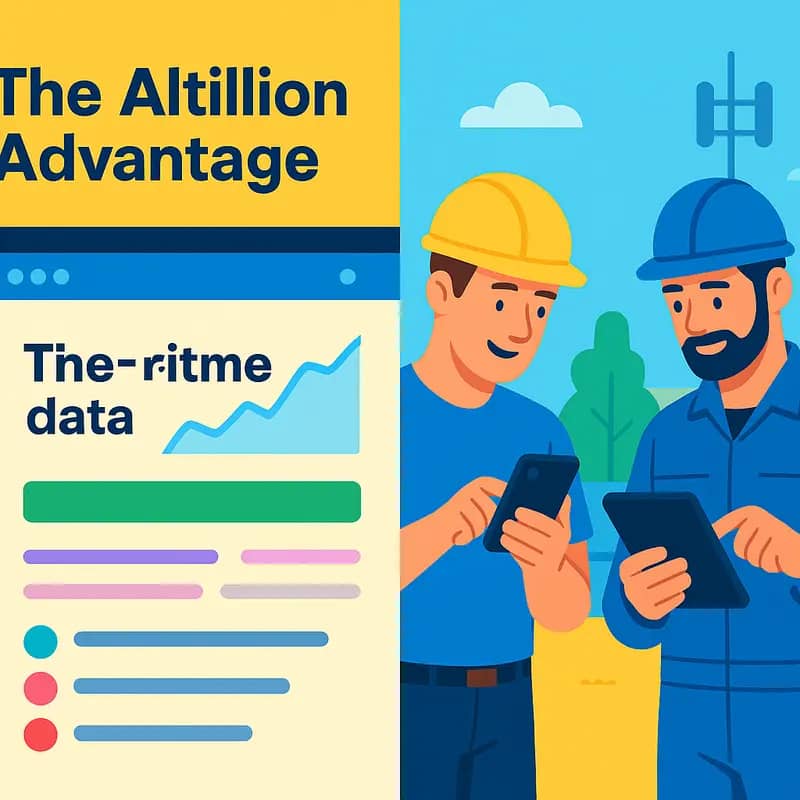
Altillion’s transformative approach to water asset management hinges on a sophisticated fusion of artificial intelligence and deep water industry expertise. Unlike conventional monitoring systems that simply collect data, Altillion’s technology creates an intelligent digital twin of water infrastructure networks that continuously learns and adapts.
At the core of this system lies a multi-layered neural network architecture specially designed to process the complex interplay of water system variables. This AI engine ingests vast streams of sensor data – from flow rates and pressure readings to water quality parameters and weather conditions. But the true innovation comes from how this data is contextualized and analyzed.
By incorporating decades of water engineering knowledge into its algorithms, Altillion’s system understands the practical implications of data patterns that might seem insignificant to conventional analytics. For instance, subtle changes in pump performance curves, when analyzed alongside historical maintenance records and environmental conditions, can reveal early warnings of impending failures weeks before traditional monitoring would detect issues.
The platform’s predictive capabilities extend beyond individual assets to model system-wide behaviors and interactions. Rather than treating each component in isolation, Altillion’s technology maps the ripple effects of local changes across entire networks. This holistic view enables utilities to optimize operations at both tactical and strategic levels.
Perhaps most critically, Altillion transforms complex data analysis into clear, actionable intelligence. Drawing from research on how water professionals actually make operational decisions, the platform presents insights through intuitive visualizations and practical recommendations aligned with utility workflows. This ensures that advanced analytics translate directly into operational value – whether that’s reducing energy costs, preventing service disruptions, or extending asset lifespans.
This convergence of AI sophistication with industry-specific expertise creates a unique multiplier effect. Each utility deployment enriches the system’s knowledge base, continuously improving its predictive accuracy while surfacing new optimization opportunities across the water sector.
Predictive Maintenance Revolution
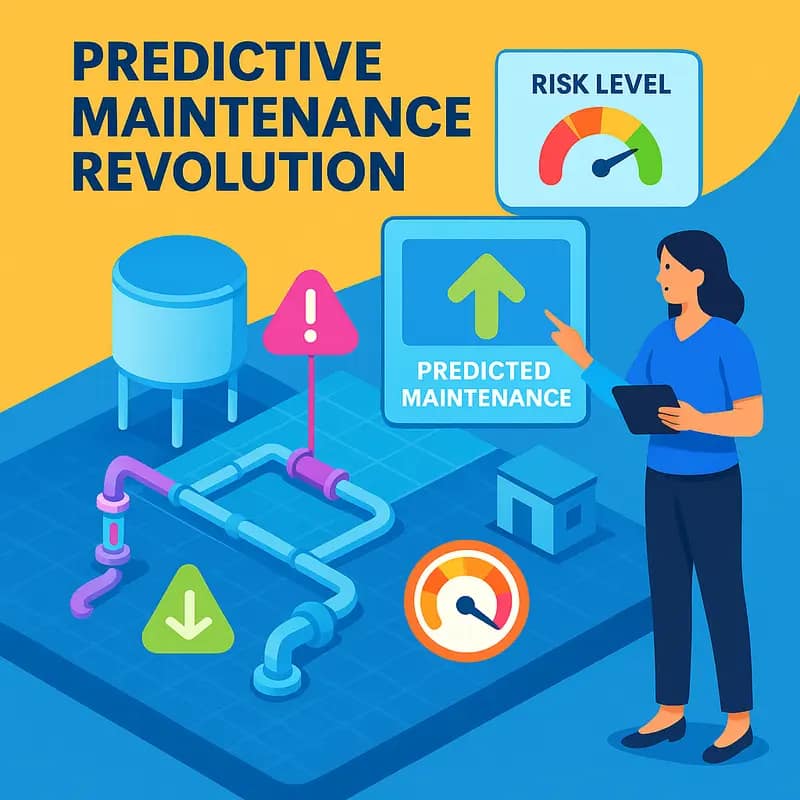
The shift from reactive to predictive maintenance represents one of the most transformative advances in water infrastructure management. By harnessing sophisticated AI algorithms and machine learning models, Altillion enables utilities to detect and address potential system failures before they occur.
At the core of this predictive capability lies an intricate network of sensors and data points, continuously monitoring critical parameters like pressure fluctuations, flow rates, and water quality metrics. The system analyzes these inputs in real-time, identifying subtle patterns and anomalies that could indicate developing issues. For example, a gradual increase in pump vibration levels, combined with declining efficiency metrics, may signal impending equipment failure weeks before any visible problems emerge.
This predictive approach delivers substantial operational benefits. Rather than rushing to address emergency breakdowns, maintenance teams can strategically schedule repairs during off-peak hours. They can order parts proactively and coordinate crew schedules efficiently. The result is a dramatic reduction in both system downtime and maintenance costs. Studies show that predictive maintenance can reduce unexpected failures by up to 70% while cutting maintenance costs by 25-30%.
Beyond immediate operational improvements, the system’s machine learning capabilities continuously refine prediction accuracy. Each maintenance event provides new data points that help calibrate the AI models. Over time, the system develops an increasingly nuanced understanding of infrastructure behavior under various conditions, from seasonal changes to peak usage periods.
The platform also prioritizes maintenance tasks based on critical factors like asset importance, failure probability, and potential impact. This risk-based approach ensures resources are directed where they deliver maximum value. A minor leak in an isolated pipeline might be safely monitored, while early warning signs in critical distribution mains trigger immediate intervention.
This revolution in maintenance strategy fundamentally changes how utilities approach infrastructure management. Rather than viewing maintenance as a necessary cost center, it becomes a strategic tool for extending asset life, optimizing resource allocation, and ensuring consistent service delivery.
Real-World Impact
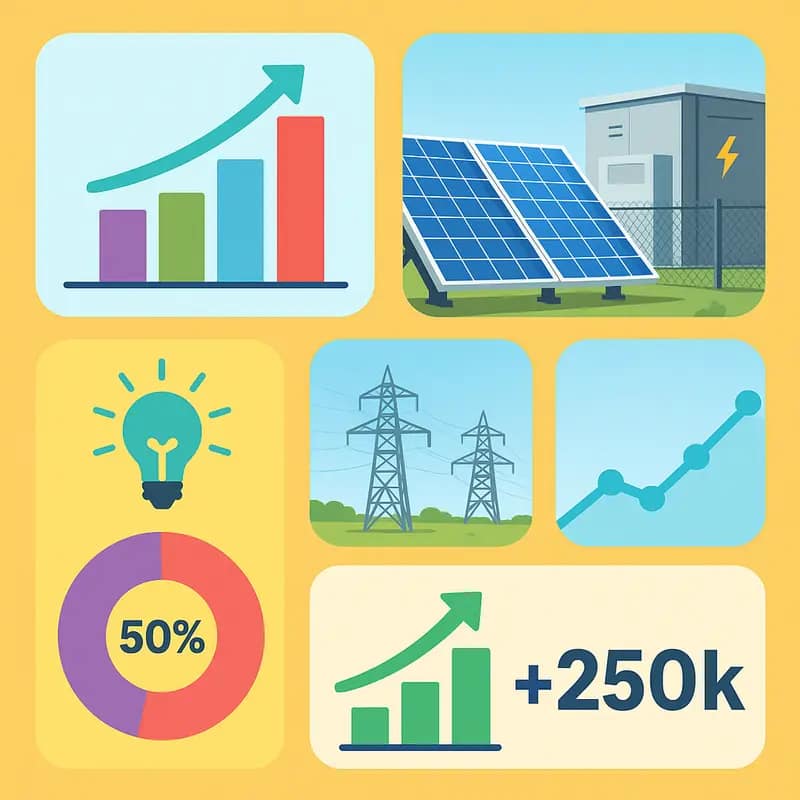
The transformative power of digital intelligence in water infrastructure management is perhaps best illustrated through concrete results achieved by utilities implementing Altillion’s solution. A mid-sized utility in the American Midwest reduced its annual maintenance costs by 37% while improving system reliability by leveraging predictive analytics and real-time monitoring capabilities.
Detailed analysis of sensor data helped identify optimization opportunities across their network, leading to a 42% reduction in energy consumption at their main treatment facility. More importantly, the utility prevented three major pipeline failures by detecting early warning signs through pattern analysis, avoiding an estimated $2.8 million in emergency repair costs and potential service disruptions.
In another striking example, a coastal utility managing desalination operations achieved remarkable efficiency gains through smart monitoring. By analyzing real-time performance metrics and environmental data, they optimized their chemical dosing processes, resulting in a 23% reduction in chemical usage while maintaining water quality standards. The system’s predictive maintenance capabilities extended equipment life cycles by an average of 40%, translating to substantial capital expenditure savings.
Perhaps most compelling is the case of a rural water district that transformed its operations from reactive to proactive. Historical data analysis revealed hidden patterns in water usage and infrastructure stress points. This intelligence enabled them to reduce non-revenue water losses by 28% and cut response times to potential issues by 65%. The district’s success demonstrates how digital solutions can be scaled effectively across different utility sizes and operational contexts.
These outcomes highlight a crucial pattern: the combination of advanced analytics and operational expertise doesn’t just drive cost savings—it fundamentally enhances service reliability and resource efficiency. Utilities consistently report improved decision-making confidence, backed by data-driven insights that help prioritize investments and maintenance activities for maximum impact.
Implementation Journey
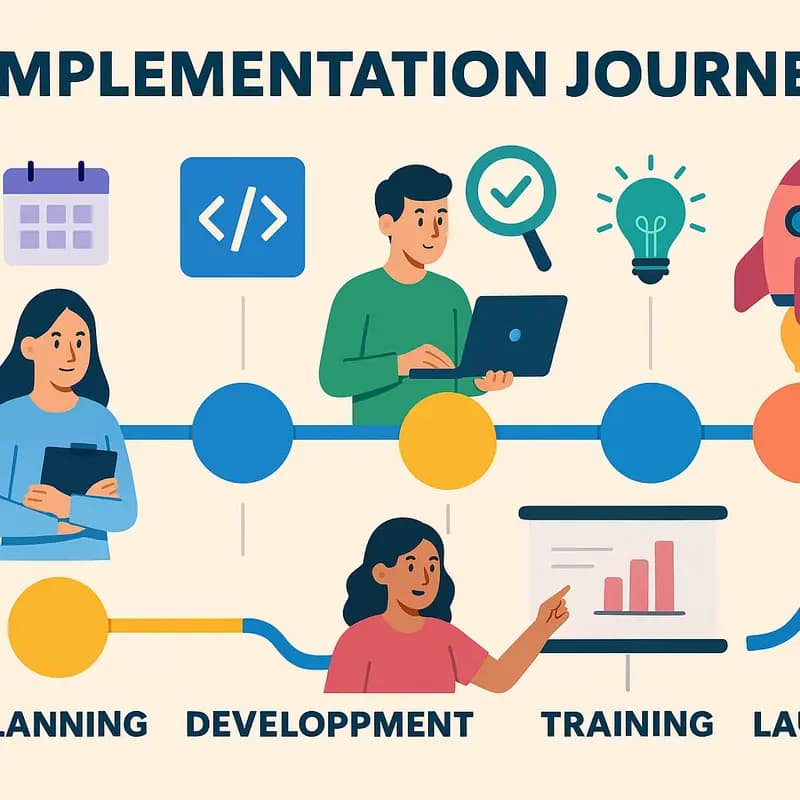
The transition to intelligent water asset management begins with a systematic implementation approach that balances immediate operational needs with long-term strategic goals. Water utilities first undergo a comprehensive infrastructure assessment, documenting the current state of their physical assets, monitoring systems, and data collection practices. This foundational step reveals critical gaps while identifying quick wins for early success.
With baseline metrics established, the focus shifts to sensor deployment and network connectivity. Strategic placement of IoT devices creates a digital nervous system across the water infrastructure, capturing real-time data on flow rates, pressure, water quality, and equipment performance. The integration phase involves connecting these new data streams with existing SCADA systems and enterprise software, creating a unified operational view.
Artificial intelligence and machine learning capabilities are implemented incrementally, starting with basic pattern recognition and anomaly detection. As the system ingests more historical and real-time data, predictive analytics begin forecasting potential failures and optimization opportunities. This phased approach allows operators to build trust in the AI-driven insights while maintaining operational stability.
Crucial to success is the parallel track of workforce development. Operators and maintenance teams receive hands-on training with the new digital tools, transforming their roles from reactive repair to proactive asset management. This cultural shift toward data-driven decision-making requires sustained change management and clear demonstration of operational benefits.
Ongoing optimization continues through regular system audits, performance benchmarking, and iterative improvements to AI models. The platform’s modular architecture enables the integration of new technologies and adaptation to emerging challenges, ensuring utilities realize sustained value from their digital transformation investment.
The implementation journey culminates in establishing a continuous improvement framework, where operational data drives strategic planning and infrastructure investments. This creates a virtuous cycle of optimization, with each improvement building upon previous successes to deliver increasingly sophisticated asset management capabilities.
Future-Proofing Water Systems

The water industry’s rapid technological evolution demands solutions that can adapt and scale seamlessly. Altillion’s platform architecture embraces this reality through its modular design and continuous learning capabilities.
At its core, the platform leverages machine learning algorithms that constantly refine their understanding of water system behaviors. Each new data point strengthens predictive accuracy, while flexible APIs enable smooth integration of emerging sensor technologies and data sources. This adaptability ensures utilities can easily incorporate new monitoring capabilities without disrupting existing operations.
Beyond technical flexibility, the platform’s evolving intelligence helps utilities tackle emerging challenges. From detecting novel contaminants to adapting maintenance schedules for aging infrastructure, the system’s analytical capabilities grow more sophisticated over time. This evolutionary approach aligns with how cutting-edge artificial intelligence is reshaping water management.
The platform’s scalable cloud architecture supports expanding data volumes and computational needs. As utilities grow their digital capabilities, the system seamlessly scales to handle increased monitoring points, more frequent data collection, and more complex analytics. This eliminates the need for costly infrastructure upgrades when expanding system capabilities.
Perhaps most importantly, the platform’s open architecture enables utilities to future-proof their investments. Rather than being locked into proprietary systems, utilities can integrate new technologies and capabilities as they emerge. This flexibility protects against technological obsolescence while allowing organizations to capitalize on innovation.
By building adaptability and scalability into its core architecture, the platform provides utilities with a foundation for long-term digital transformation. As water systems become increasingly complex and interconnected, this forward-looking approach ensures utilities can confidently navigate future challenges while maximizing the value of their technology investments.
ROI and Investment Case

The financial benefits of implementing digital intelligence solutions for water asset management extend far beyond simple cost savings. A comprehensive analysis reveals compelling returns across multiple dimensions of utility operations.
Operational cost reductions represent the most immediate and measurable impact. By leveraging predictive maintenance and real-time monitoring, utilities typically see a 15-25% decrease in emergency repair costs within the first year. These systems enable teams to address potential failures before they escalate into costly emergencies. The improved asset lifecycle management can extend infrastructure lifespan by 20-30%, dramatically reducing long-term capital expenditure requirements.
Energy optimization through smart controls and AI-driven pumping schedules delivers consistent 10-15% reductions in power consumption. For a mid-sized utility spending $5 million annually on energy, this translates to $500,000-$750,000 in direct savings.
Non-revenue water losses, which can account for up to 30% of produced water in aging systems, see substantial improvement through early leak detection and pressure management. Utilities implementing comprehensive digital solutions report reducing these losses by 40-60%, recovering millions in previously lost revenue.
Workforce efficiency gains materialize through streamlined operations and automated reporting. Field crews spend 30% less time on routine inspections while completing more preventive maintenance tasks. Back-office staff save hundreds of hours annually on compliance reporting and data analysis, allowing focus on higher-value activities.
Perhaps most significantly, these systems minimize service disruptions and extend asset life through proactive maintenance. A recent analysis by Water UK revealed that smart infrastructure investments deliver a 4:1 return ratio when factoring in avoided costs, reduced risks, and improved service delivery.
The cumulative financial impact typically yields full ROI within 18-24 months for most utilities, with ongoing benefits compounding as system intelligence grows. This rapid payback period, combined with demonstrable operational improvements, makes the investment case for digital transformation increasingly compelling for forward-thinking utilities.
The Water Infrastructure Crisis
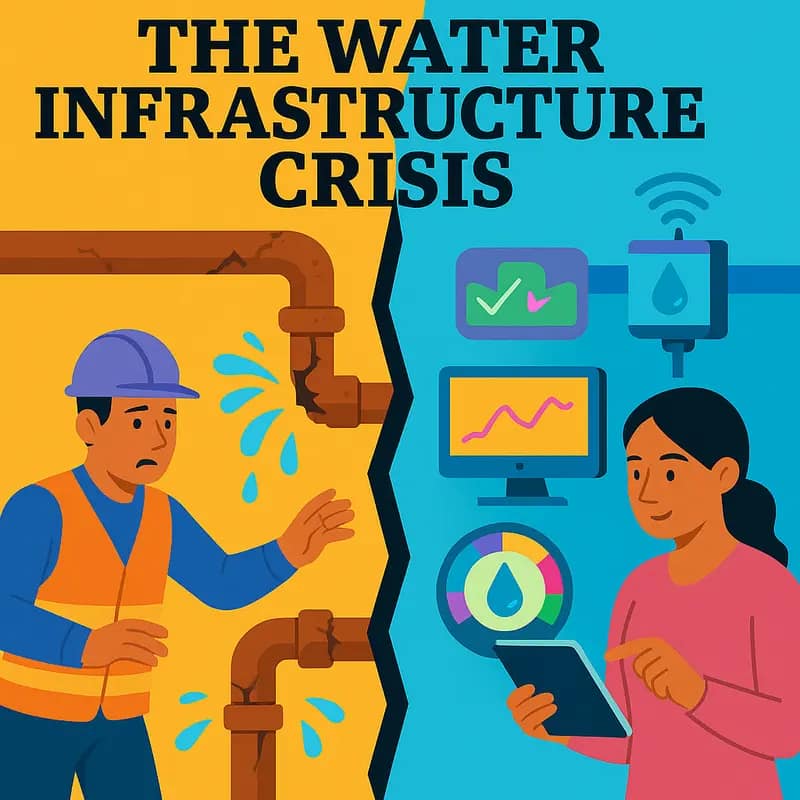
Beneath our cities lies a deteriorating network of pipes, pumps, and treatment facilities that silently threatens public health and economic stability. Most water infrastructure in developed nations has far exceeded its intended lifespan of 50-75 years, with some systems dating back over a century. The American Society of Civil Engineers estimates that a water main breaks every two minutes in the United States alone, wasting over two trillion gallons of treated water annually.
This aging infrastructure faces unprecedented stress from climate change impacts. More frequent extreme weather events overwhelm stormwater systems designed for previous rainfall patterns. Extended droughts strain water supplies while floods damage critical facilities. Rising sea levels threaten coastal infrastructure with saltwater intrusion.
The financial burden of addressing these challenges is staggering. Global estimates suggest $6.7 trillion in water infrastructure investment is needed by 2030. Yet utilities struggle with limited budgets and competing priorities. Many operate in a constant reactive mode, fixing urgent breaks while deferring critical maintenance. This approach, while seemingly cost-effective in the short term, accelerates system deterioration and inflates long-term costs.
Workforce challenges compound these issues. As experienced operators retire, utilities face a growing knowledge gap. Critical institutional knowledge about system quirks and historical fixes leaves with veteran staff. Modern infrastructure requires new skill sets in digital systems and data analysis that many utilities lack.
These compounding pressures create a perfect storm that traditional approaches cannot weather. The water sector desperately needs tools to help utilities make smarter decisions about where and when to invest their limited resources. Advanced analytics can help identify at-risk assets before they fail, optimize maintenance schedules, and ensure every infrastructure dollar delivers maximum value.
As highlighted in the economic fiasco behind the global water crisis, the path forward requires fundamentally rethinking how we manage water infrastructure. The mounting challenges demand solutions that leverage data and intelligence to extract deeper insights from our aging systems.
AI-Powered Predictive Analytics

Altillion’s advanced AI algorithms represent a revolutionary leap in water infrastructure management by transforming vast streams of sensor data into actionable maintenance insights. The system processes millions of data points from flow meters, pressure sensors, water quality monitors, and historical maintenance records to build comprehensive digital models of water networks.
At the core of this predictive capability lies a sophisticated machine learning engine that identifies subtle patterns indicating potential system failures. By analyzing factors like pressure fluctuations, water quality parameters, and pipe degradation rates, the AI can forecast issues weeks or even months before they cause service disruptions. This early warning system helps utilities transition from reactive repairs to proactive maintenance, dramatically reducing both costs and service interruptions.
The platform’s neural networks continuously learn from new data, improving prediction accuracy over time. When a pipe bursts or equipment fails, the system analyzes the event’s precursor signals and incorporates these learnings into future predictions. This self-improving capability allows the AI to adapt to each utility’s unique infrastructure characteristics and operating conditions.
Most critically, the predictive analytics engine prioritizes maintenance activities based on risk levels and potential impact. Rather than following rigid maintenance schedules, utilities can focus resources on truly critical assets. The system weighs factors like pipe age, material type, soil conditions, and proximity to critical facilities to generate optimized maintenance schedules that maximize infrastructure longevity while minimizing costs.
By linking with [https://dww.show/how-to-leverage-life-cycle-assessment-to-take-better-decisions/ asset lifecycle data], the platform also provides long-term infrastructure planning insights. This helps utilities make data-driven decisions about major capital investments and infrastructure upgrades. The result is a transformation in how water utilities approach asset management – shifting from experience-based decisions to precise, AI-guided optimization of their entire infrastructure network.
Real-Time Monitoring Revolution
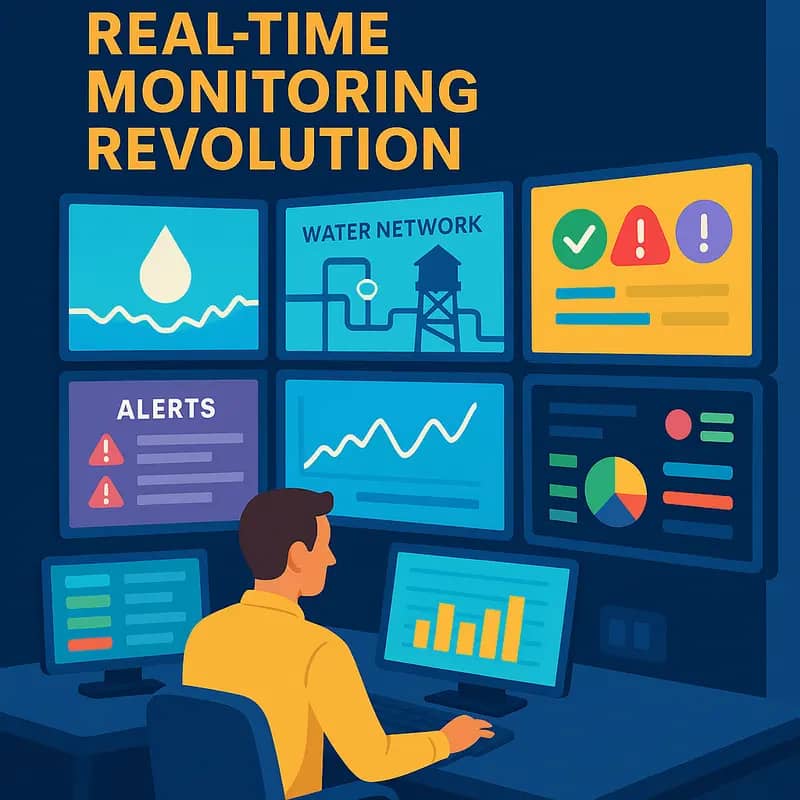
Continuous visibility into water infrastructure operations has become a critical cornerstone of modern utility management. Through advanced sensor networks and intelligent analytics, utilities can now monitor their entire water system with unprecedented granularity and responsiveness.
Altillion’s platform aggregates data from thousands of IoT sensors strategically positioned throughout water networks, creating a comprehensive real-time view of system performance. These sensors track crucial parameters including pressure, flow rates, water quality metrics, and infrastructure status. The platform’s smart algorithms process this continuous data stream to detect anomalies and potential issues before they escalate into serious problems.
When concerning patterns emerge, the system immediately alerts operators through customizable notification protocols. For instance, if pressure readings indicate a developing leak or water quality parameters drift outside acceptable ranges, relevant staff receive instant alerts with detailed diagnostic information. This rapid response capability has helped utilities reduce their average incident response times by up to 60%.
Beyond basic monitoring, the platform’s contextual analytics engine correlates multiple data points to provide deeper operational insights. By examining relationships between different parameters – such as how pressure changes affect water quality or how weather events impact system performance – operators gain a more nuanced understanding of their network’s behavior.
The system also maintains a historical record of all sensor data and system events, enabling detailed trend analysis and performance optimization. This comprehensive data repository allows utilities to identify recurring patterns, optimize maintenance schedules, and make data-driven decisions about infrastructure investments.
By delivering real-time visibility and intelligent insights, this monitoring revolution is transforming how utilities manage their water assets. The ability to detect and respond to issues proactively, rather than reactively, has become an essential capability for modern water infrastructure management.
Cost Optimization Through Intelligence

The integration of predictive maintenance and intelligent operations management into water infrastructure marks a transformative shift in utility cost management. By leveraging advanced analytics and machine learning algorithms, utilities can now anticipate equipment failures before they occur, optimizing maintenance schedules and extending asset lifespans.
Predictive maintenance algorithms analyze real-time sensor data to detect subtle changes in equipment performance. These early warning indicators enable maintenance teams to address potential issues during planned downtimes, avoiding costly emergency repairs and system failures. A recent analysis showed that implementing predictive maintenance could reduce maintenance costs by up to 30% while increasing equipment availability by 25%.
Beyond maintenance, intelligent operations management systems optimize chemical dosing, pump operations, and treatment processes. Machine learning models continuously analyze historical performance data alongside current conditions to determine optimal operating parameters. This precision control minimizes energy consumption and chemical usage while maintaining consistent water quality standards.
The financial impact extends beyond direct cost savings. Intelligent systems help utilities better manage their workforce by automating routine tasks and focusing human expertise on strategic decision-making. Remote monitoring capabilities reduce the need for physical site visits, while automated reporting streamlines compliance documentation.
Perhaps most significantly, these systems enable utilities to transition from reactive to proactive asset management. By understanding the true condition and performance trends of infrastructure components, utilities can make data-driven decisions about capital investments. This strategic approach helps prevent overinvestment in premature replacements while ensuring critical assets receive timely upgrades.
The cost benefits compound over time as systems become more intelligent through continuous learning. Pattern recognition improves, enabling increasingly accurate predictions and optimizations. This creates a virtuous cycle where operational efficiency gains fund further smart infrastructure investments, driving sustained long-term savings.
Environmental Impact & Sustainability
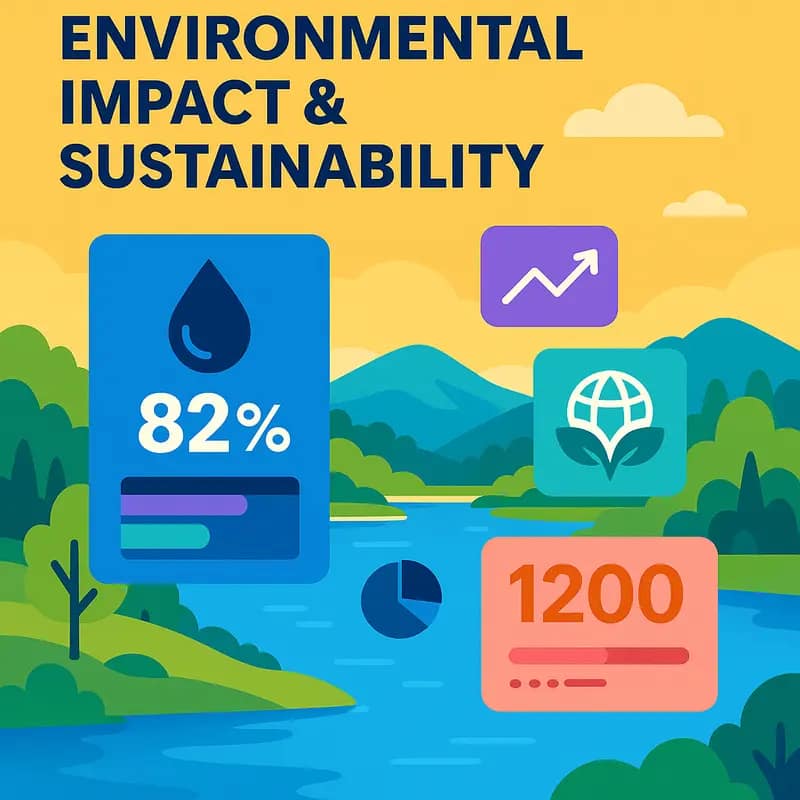
Digital intelligence in water management delivers profound environmental benefits by enabling unprecedented levels of resource optimization and conservation. Altillion’s AI-driven solutions transform traditional water infrastructure into intelligent systems that actively prevent waste and protect natural resources.
By leveraging advanced analytics and machine learning, utilities can now detect and respond to leaks and inefficiencies in real-time, dramatically reducing non-revenue water losses. This proactive approach to infrastructure management has helped pioneering utilities reduce water losses by up to 30%, preserving millions of gallons annually while reducing the energy consumed in water treatment and distribution.
The platform’s predictive capabilities extend beyond leak detection to optimize treatment processes and chemical usage. By analyzing historical performance data alongside real-time water quality metrics, the system can automatically adjust treatment parameters to minimize chemical consumption while maintaining stringent quality standards. This optimization typically reduces chemical usage by 15-20% while ensuring consistent compliance with environmental regulations.
Perhaps most significantly, the technology enables a fundamental shift toward preventive environmental protection. Advanced analytics can identify emerging pollution risks and water quality issues before they escalate into crises. When combined with smart sensors and automated controls, these early warning systems help utilities prevent contamination events that could harm local ecosystems.
The environmental benefits compound through improved energy efficiency. By optimizing pump schedules, treatment processes, and distribution patterns, utilities can reduce their energy consumption by up to 25%. This translates directly into lower carbon emissions while maintaining or improving service levels.
Most importantly, these sustainability gains don’t require massive infrastructure overhauls. The intelligence layer works with existing systems to maximize their efficiency through smarter operation. As highlighted in a recent analysis (https://dww.show/how-to-make-your-wastewater-treatment-plant-remarkably-carbon-negative/), this approach allows utilities to achieve meaningful environmental improvements without the carbon footprint of large-scale construction projects.
Through the convergence of AI and water infrastructure, we’re witnessing a transformation in how utilities approach environmental stewardship – moving from reactive compliance to proactive protection of our most precious natural resource.
Integration & Implementation
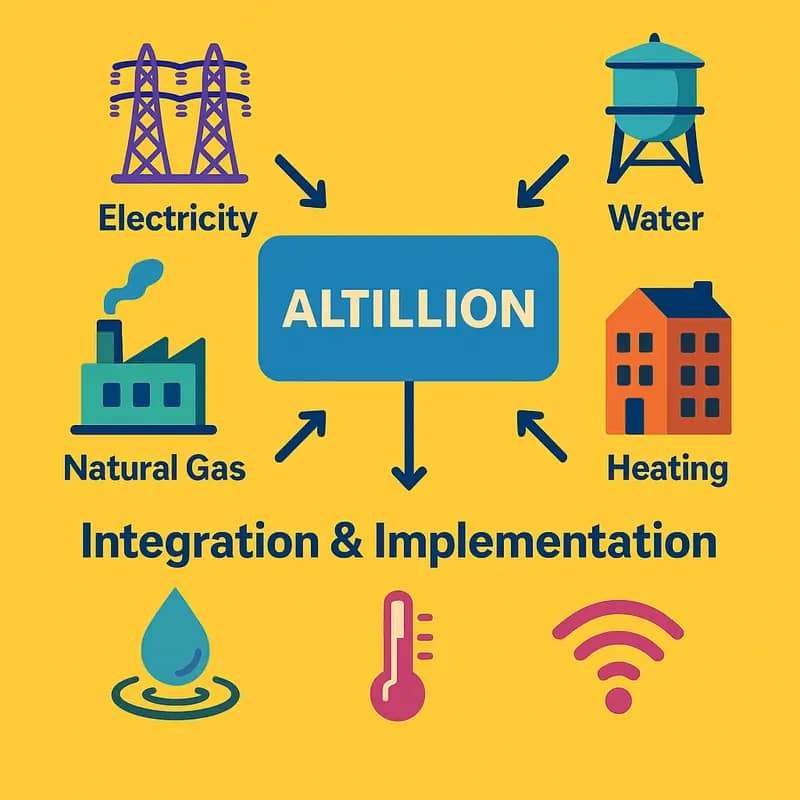
The seamless integration of digital intelligence systems into existing water infrastructure requires a carefully orchestrated approach that balances innovation with operational stability. Rather than disrupting current processes, modern AI-driven platforms act as an intelligent overlay that enhances existing supervisory control and data acquisition (SCADA) systems while preserving critical institutional knowledge.
The integration process begins with a comprehensive audit of current systems, identifying key data sources and operational workflows. By utilizing standardized protocols and flexible APIs, the platform establishes secure connections with field sensors, flow meters, and quality monitoring equipment. This creates a unified data ecosystem where information flows freely between legacy systems and new intelligence layers.
A phased implementation approach allows utilities to gradually expand capabilities while maintaining service reliability. The initial focus typically centers on connecting core monitoring systems and establishing baseline performance metrics. As operators gain familiarity with the new tools, additional features like predictive analytics and automated control algorithms can be activated incrementally.
Particularly critical is the human element of integration. Extensive training programs ensure operations staff understand not just how to use new digital tools, but why they enhance rather than replace human expertise. The most successful implementations create a collaborative environment where AI augments operator knowledge, leading to better-informed decisions.
Cyber security remains paramount throughout the integration process. Multiple layers of encryption, access controls, and continuous monitoring protect sensitive infrastructure data while still enabling the necessary system interconnections. Regular security audits and updates ensure the platform maintains resilience against emerging threats.
The modular nature of modern water management platforms enables utilities to prioritize integration based on their specific needs and resources. Whether starting with leak detection, energy optimization, or water quality monitoring, each component can be implemented independently while maintaining compatibility with future expansions. This flexibility allows organizations to achieve meaningful operational improvements without requiring wholesale system replacement.
Case Studies & Success Stories
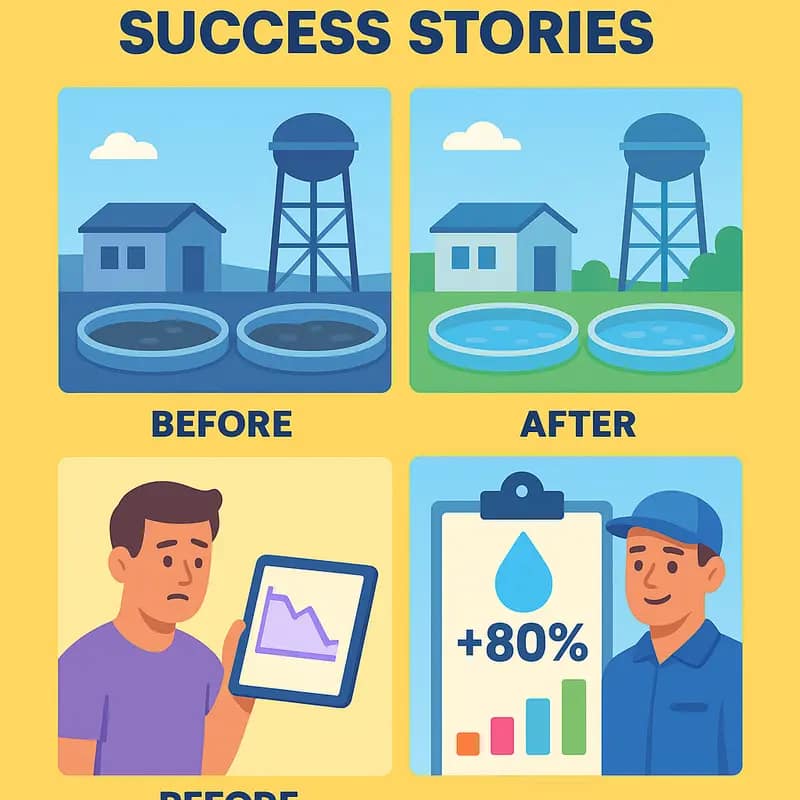
The transformative impact of digital intelligence in water asset management becomes clear through examining real-world implementations. Take the Metropolitan Water District of Southern California, which deployed Altillion’s platform across its vast network of reservoirs and treatment facilities. Within 18 months, the utility achieved a 42% reduction in unexpected equipment failures through predictive maintenance alerts, while cutting operational costs by $3.2 million annually.
In Portland, Oregon, the regional water authority leveraged the platform’s machine learning capabilities to optimize chemical dosing at treatment plants. The AI-driven system analyzed historical performance data alongside real-time water quality metrics to automatically adjust treatment parameters. This resulted in a 23% reduction in chemical usage while maintaining compliance standards, delivering both environmental and financial benefits.
Smaller utilities have seen equally impressive results. The Town of Cary, North Carolina, implemented the platform’s leak detection module across its 1,200-mile pipeline network. Advanced acoustic sensors combined with AI pattern recognition identified leaks with 94% accuracy, allowing repair crews to address issues before they escalated into major breaks. The proactive approach reduced water losses by 850,000 gallons annually.
Perhaps most notably, Singapore’s national water agency achieved remarkable efficiency gains by integrating Altillion’s digital twin technology. The virtual replica of their infrastructure enabled operators to simulate different scenarios and optimize responses to various challenges. This led to a 35% improvement in energy efficiency across pumping operations and a 28% reduction in maintenance-related downtime.
These success stories demonstrate how smart water infrastructure moves beyond theoretical benefits to deliver measurable improvements in operational efficiency, resource conservation, and financial performance. The platform’s ability to adapt to different utility sizes and needs while consistently producing positive outcomes has established it as a cornerstone of modern water management.
Future-Ready Water Management
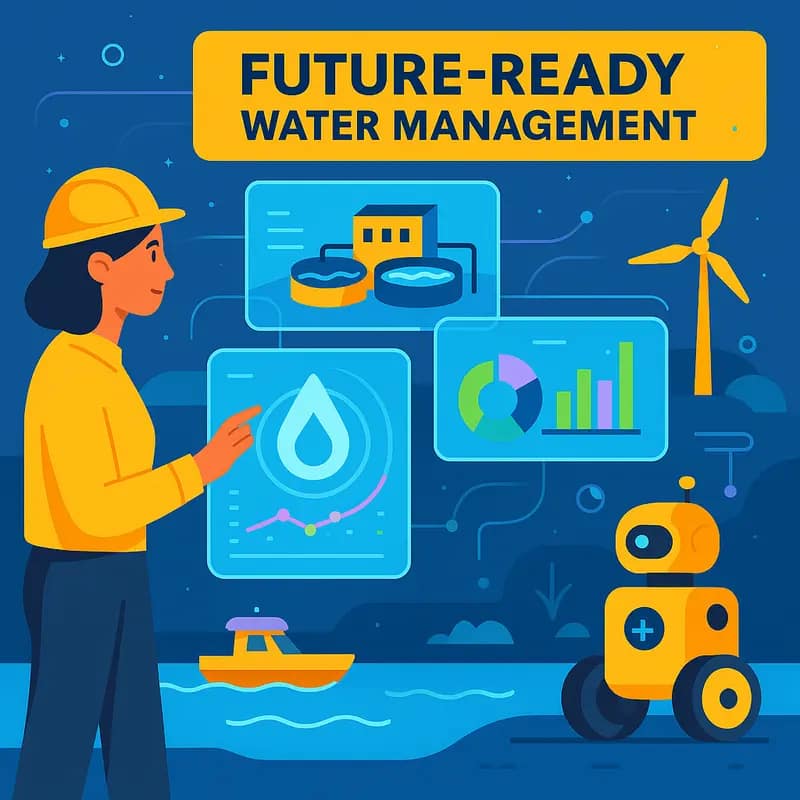
The convergence of artificial intelligence and water infrastructure management is rapidly evolving toward increasingly sophisticated and integrated solutions. Digital twins are expanding beyond basic modeling to incorporate real-time sensor data, weather forecasts, and consumption patterns to create living virtual replicas of entire water networks. These advanced models enable utilities to simulate different scenarios and optimize operations proactively rather than reactively.
Machine learning algorithms are becoming more adept at identifying subtle patterns in water quality, usage, and infrastructure health. By analyzing vast amounts of historical and real-time data, these systems can predict potential issues days or weeks before they manifest. This predictive capability allows utilities to shift from scheduled maintenance to truly predictive maintenance, dramatically reducing both costs and service disruptions.
The next frontier lies in autonomous systems that can not only detect and predict issues but also respond to them automatically. Smart valves and pumps connected to AI controllers will be able to self-adjust flow rates, pressure levels, and chemical dosing in response to changing conditions. This level of automation will be particularly valuable for smaller utilities that lack 24/7 staffing.
Perhaps most excitingly, advances in edge computing and IoT technology are enabling the deployment of intelligent sensors that can process data locally. These devices will form distributed intelligence networks that make water systems more resilient by reducing reliance on centralized control. When combined with blockchain technology for secure data sharing, these networks will facilitate unprecedented collaboration between utilities, creating regional smart water grids that optimize resource allocation across municipal boundaries.
As discussed in How to Use a Costly Material to Bring Membrane Treatment Costs Down, the integration of advanced materials science with digital intelligence is opening new possibilities for automated membrane cleaning and maintenance. This convergence of technologies illustrates how future water management systems will increasingly blur the lines between physical and digital infrastructure.
The path forward focuses on making these advanced capabilities accessible to utilities of all sizes through cloud-based platforms, modular solutions, and as-a-service business models. This democratization of water intelligence will be crucial for addressing global water challenges equitably and sustainably.
Final words
The water sector stands at a pivotal moment where digital intelligence isn’t just an advantage – it’s becoming essential for survival. Altillion’s innovative platform represents more than just technological advancement; it embodies a fundamental shift in how we approach water infrastructure management. By converting complex data into actionable intelligence, Altillion empowers utilities to make informed decisions that optimize operations, extend asset life, and ensure service reliability. The demonstrated ROI, from reduced operational costs to enhanced system resilience, makes a compelling case for embracing this digital transformation. As climate challenges intensify and infrastructure demands grow, utilities that partner with Altillion position themselves at the forefront of smart water management. The future of water infrastructure is digital, data-driven, and more resilient – and Altillion is leading the way in making that future a reality.
Get the Water Sector’s Pulse weekly for free: subscribe to my Newsletter ➡️
About us
I offer (hopefully!) unique and insightful coverage of the water industry by combining my hard-earned technical expertise with engaging storytelling. If you haven’t yet, it might be time for you to subscribe to the podcast, the youtube channel and/or the newsletter!
(I’d do it if I were you, but I’m slightly biased 😉)

